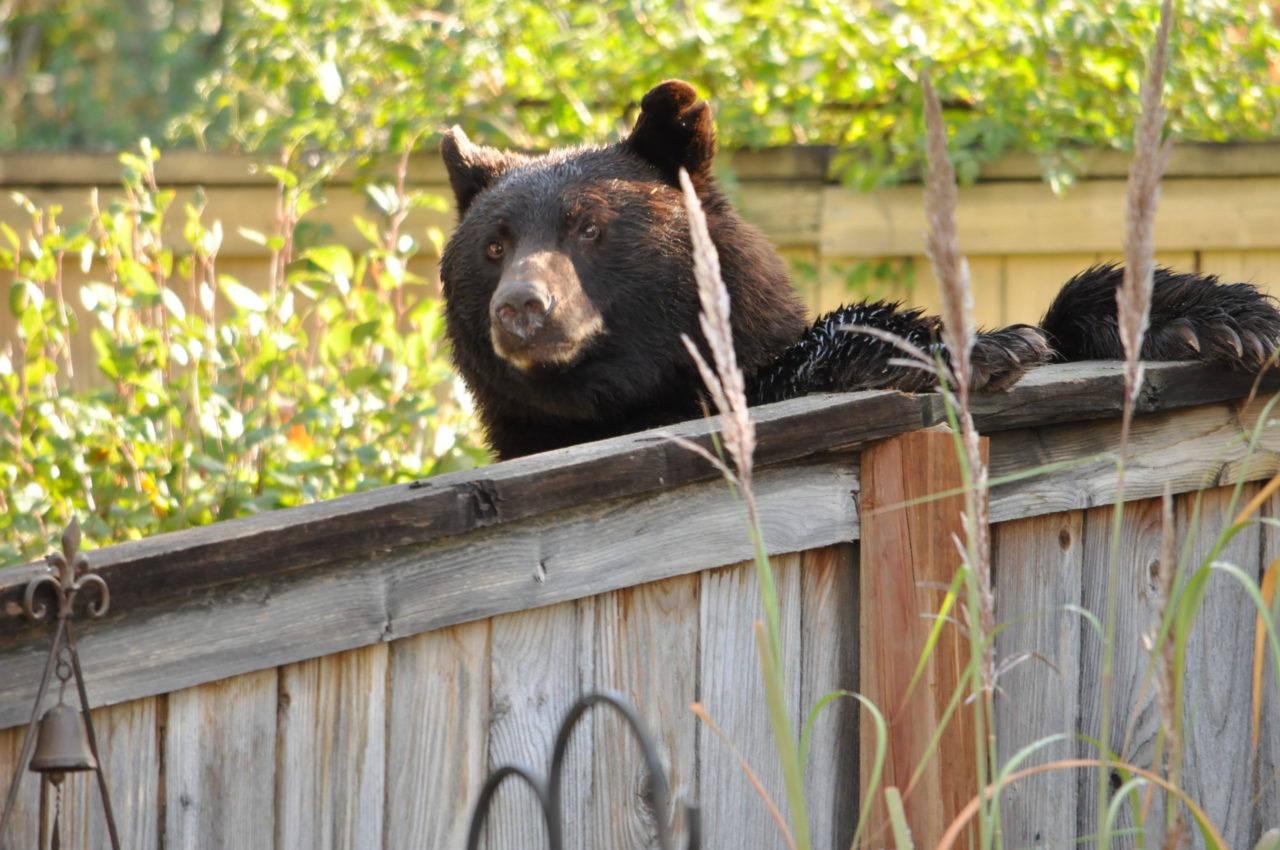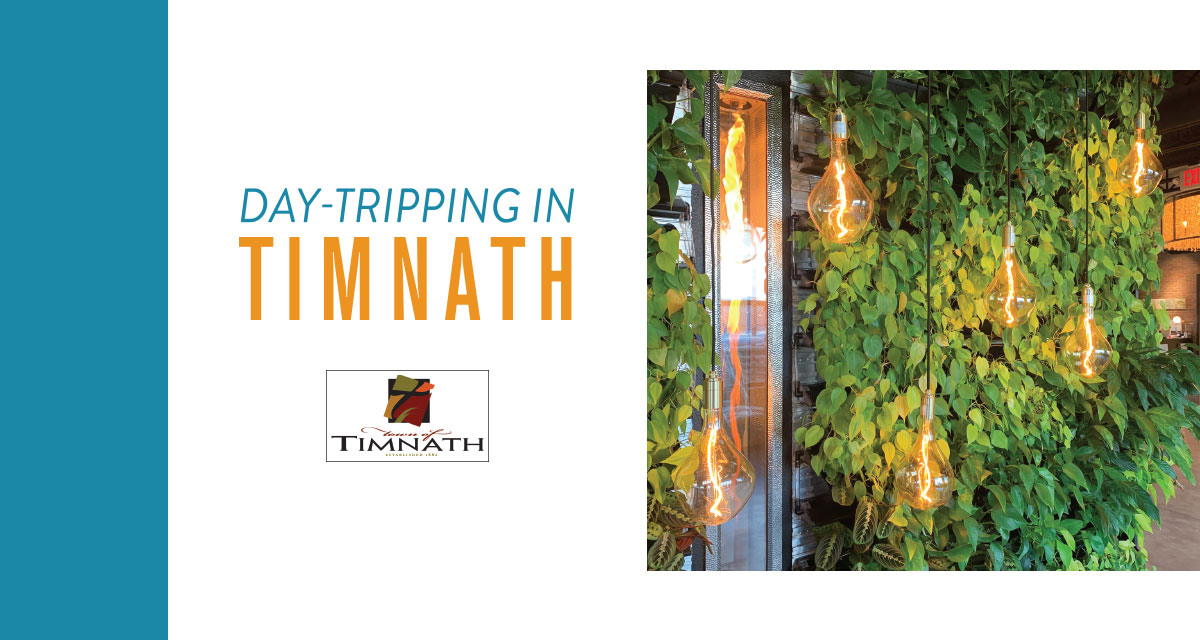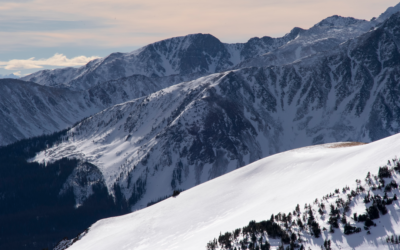When humans and wild predators interact,
it’s usually the animals that pay the price.
Later, she would weep for it.
She thought the black bear was beautiful when he rambled out of a bush, a big, fluffy ball of milk chocolate, and she admired him as she tried to give him room to move past. She had seen bears in the wild before, but they were dots in the distance during a trip to Yellowstone, not the up-close encounter they got after surprising each other on a Colorado trail.
A biologist who works in the Pacific Northwest National Laboratory in Richmond, Wash., Jansson loves animals and hates the way human development continues to encroach on their habitat. On the drive to the trailhead, she ranted almost continuously about all the homes in the mountains. “Where would the animals go?” she kept wondering. Whenever she heard about human-animal conflicts, especially those with bears, she usually sided with the animals.
Now, seeking to defuse an animal conflict of her own, Jansson and her husband, Christer, backed up slowly on the trail as much as they could. Unfortunately, a
fast-moving stream prevented them from giving the bear the yards of space they would have preferred. They didn’t run. She thought about trying to make herself look big, but Christer was already 6’ 6”, and she wasn’t a tiny person either. So they retreated all the way to the bank and waited for the bear to pass them.
He did – and then, almost as an afterthought, shoved her and bit her on the leg.
Oh, you stupid bear, she thought. She yelled at it: “No! Go away!”
“It hurt, but I was mainly annoyed,” Jansson says now. “It was just so unnecessary.”
She told Christer she could keep hiking, but then she saw blood pooling in her leggings from two puncture wounds and a bruise that surrounded them. She lay down, and Christer soaked her fleece in the cold water and tied it around her leg, and they waited for the bleeding to stop before they walked 10 minutes out to the trailhead. She got treated at the ER and released, and she thought that would be the end of it. But a couple of officers from Colorado Parks and Wildlife were waiting to talk to her. After describing what happened, she learned they would have to put the bear down.
“I got hysterical,” she says. “I just couldn’t stop crying. I felt horrible. I just kept saying, ‘It’s my fault. It’s my fault.’”
But it wasn’t her fault, by all accounts – any more than it was Travis Kauffman’s fault when he was attacked by a young mountain lion in February on a trail outside of Fort Collins. Kauffman choked the lion to death and found a little fame as a result. He recently told the Colorado Sun that no signs of the attack remain, save for a couple faint scars. He’s not suffering from PTSD. He continues to run and recently completed his first 50K trail race.
Attacks like those are extremely rare. The state knows of only 20 lion attacks in the past 30 years. Bear attacks are more common, but black bears are relatively gentle and skittish around humans. They almost never attack unless they’re provoked. Most of the time, when wildlife officers have to destroy an animal, it’s because of human mistakes.
In the attack on Janet Jansson, the critical mistake seems to have been committed by a whole community. The bear had been frequenting homes that sat close to the trail, and residents hadn’t secured their trash or removed their bird feeders despite warnings from wildlife officers that the bear was getting habituated to their houses. As a result, the bear lost its fear of humans.
“The frustrating thing about this course of events is that it was entirely preventable,“ says Area Wildlife Manager Matt Yamashita. “CPW officers and other local law enforcement constantly remind the public to secure trash cans and dumpsters, take down bird feeders and lock their first-floor windows. Yet calls come in daily reporting aggressive bears demonstrating no fear of humans, getting into dumpsters and residing in people’s yards. This should not be considered normal or tolerable.
“This bear died because it appears some people could not be bothered to follow a few simple, common-sense suggestions,” Yamashita adds, making no effort to mask his frustration. “We need the public’s help in keeping our bears wild.“
It’s hard to say what caused the bear’s aggression toward Jansson, but she believes he acted irked at her presence, almost as if he’d had enough of humans intruding on his territory.
“Maybe he just wanted us out of the way more,” Jansson says. “He didn’t strike me as if he wanted to kill me. I didn’t get that impression at all. I think he was just really annoyed.”
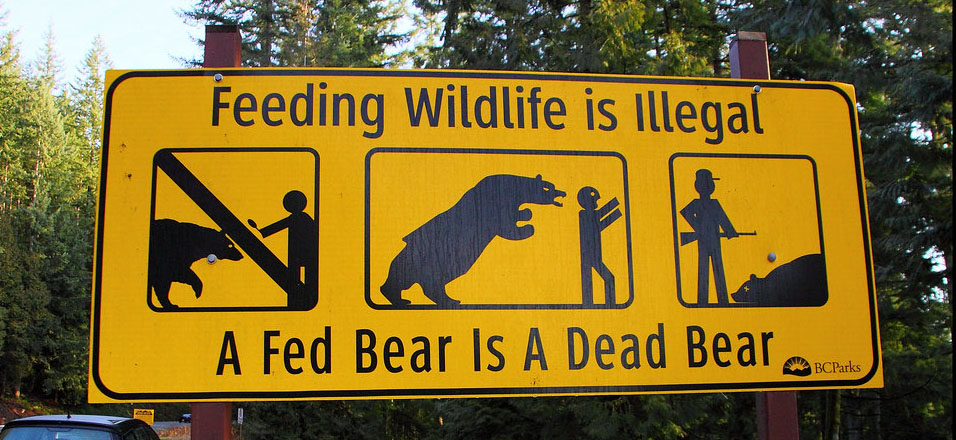
…..

Petkash’s number-one peeve is with tourists who use food to lure wild animals close in order to snap selfies with them. The problem is particularly bad in Colorado’s Lake George District, where Petkash works for CPW as a wildlife officer. His territory includes Mount Evans, whose famous alpine road draws thousands of motorists every summer. Many of those visitors offer snacks to the mountain goats that hang out near the highway.
“It’s a daily occurrence up there,” Petkash says of Mount Evans, “and 90 percent of the time, the intentional feeding is so someone can get a picture to post. They are valuing the experience of a selfie over that wildlife’s existence.”
When people disregard basic guidelines for keeping wildlife wild, Petkash says, it’s almost always the animals, not the people, who suffer. Bears, in fact, have a “two-strike” policy: If they have to be moved from an area because they are habituated to it, officers have to put the animal down if it returns. The policy against mountain goats isn’t as strict, but if they do pose a serious threat, Petkash will put them down.
Negligence and sheer stupidity aren’t the only ways to stumble into a confrontation with a wild animal. Most people know they should give a wild animal such as a bear ample space, but they often don’t know how – or won’t make the effort – to bear-proof their homes or campsites.
Bears aren’t proud; they will take free meals when they can get them. That’s especially true during autumn, when they’re preparing for winter hibernation and have to consume thousands of calories a day. They have to get fat, and as wonderful as permission to get fat sounds, they don’t usually have access to salted carmel shakes or triple cheeseburgers or fried cheese or fudge from downtown Estes Park. But they do have access to human food that isn’t properly stored in bear lockers, hung bags or canisters. When someone’s trash can, bird feeder or greasy barbecue grill regularly provides an easy source of calories, bears will tolerate humans and eventually learn not to be afraid of them. That’s when they become dangerous.
“They don’t want to be around humans,” says Jason Clay, spokesman for the Northeast region of CPW. “Most of the time they encounter humans and they run, and that’s the end of it. But when they get habituated, they expect a human to feed them, and that’s when the bad run-ins happen. Human food sources offer more calories – and for bears, calories are the name of the game.”
According to CPW, bear incidents increased this year in Roosevelt National Forest Service and in dispersed camping areas in Boulder, Clear Creek and Larimer counties. Most of the reports involve improperly stored food in trees or bears entering unoccupied tents to get scented items such as sunscreen, bug spray and marijuana. The same kinds of lax habits contributed to a spate of bear encounters this summer at campgrounds near Chambers Lake and Red Feather Lakes. In at least one of those cases, a frightened camper fired off some warning shots to scare the bear away.
Petkash and other wildlife officers are passionate about reducing human mistakes, because when they lead to a fatality – whether human or animal – it takes a toll.
“Putting down an animal is by far the worst part of my job,” he says. “It’s also one of the more frustrating parts. We get stuck with the dirty work, and in most circumstances, it’s just that people were too lazy, or they just value the attention they get from posting a picture of a bear on their deck.”
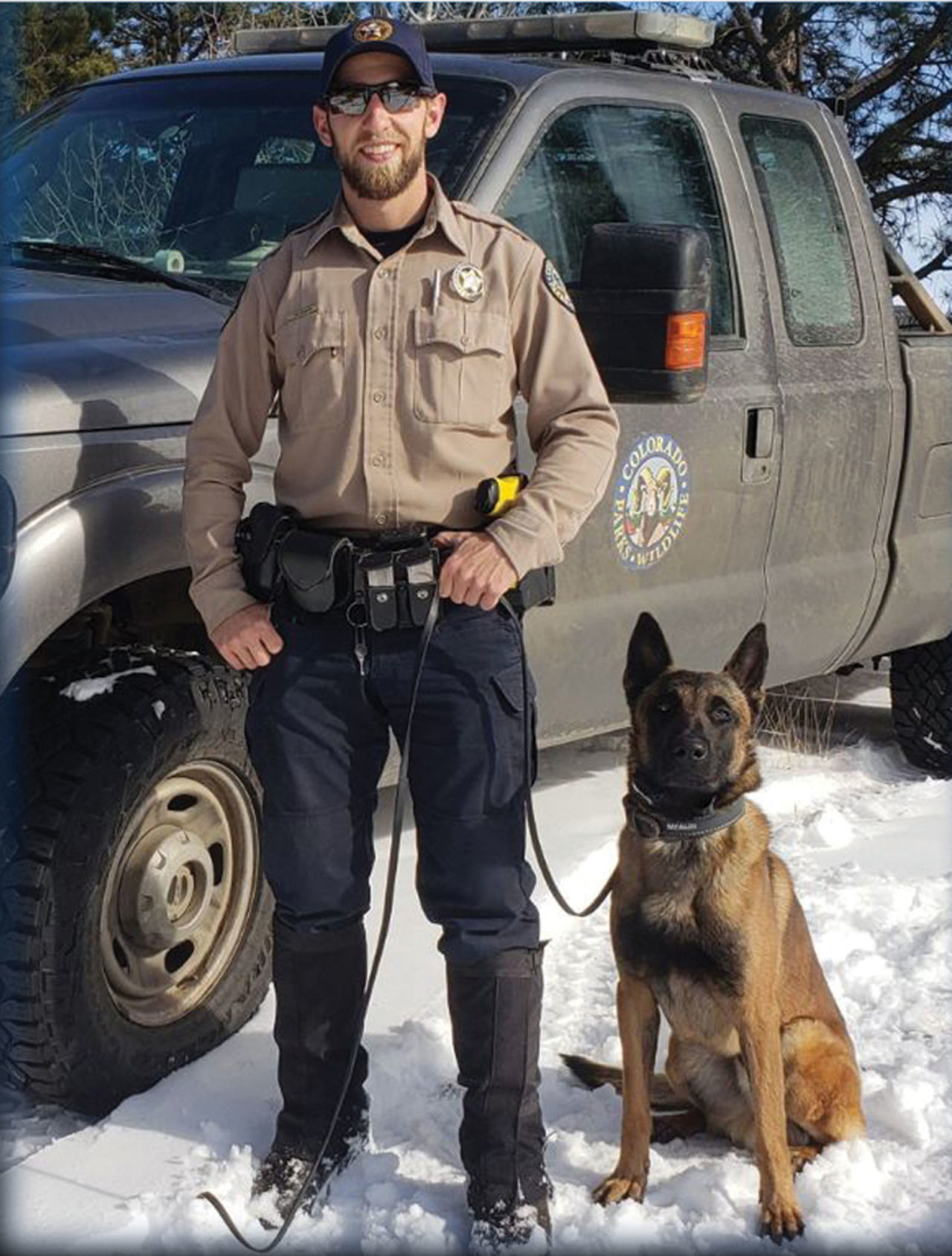
CPW wildlife officer Ian Petkash, with his dog, Samson, has made educating the public a top priority.
Wildlife population numbers are strong too, says CPW’s Clay, increasing the overlap between habitat and developed areas. “There are a lot of deer in towns now,” he says, “and elk in towns such as Estes Park. On top of that, there’s [more] outdoor recreation in the state. The potential is always going to be there.”
Therefore, creative solutions are a must. Leave it to Petkash to find one.
Petkash handles Samson, a wildlife dog that helps CPW enforce laws affecting wildlife (such as hunting and poaching restrictions). But the main part of his job is to bother bears whose behavior puts them at risk of euthanasia. The idea is for Samson to harass the bear and deter it from scavenging for trash and other free food in populated areas. It’s difficult to break a bear’s attraction to delicious, calorie-rich treats, but Samson’s barking and threatening demeanor seems to help. He can’t actually mix it up with the bear (he’s on a leash while he performs his hazing), but the bear doesn’t know that.
“We combine Samson with paintball and other techniques such as bear spray and loud noises,” Petkash says. “The idea is to make that situation as uncomfortable [for the bear] as we possibly can, short of hurting it.”
If bears can be persuaded that human food isn’t worth all the hassle, it might save their lives. The program is still being evaluated by the state, but it appears to be successful, and there are promising results elsewhere. In Washington state, more than 80 percent of the bears hazed by dogs haven’t returned to the areas where they posed a problem, Petkash says. The dogs cost thousands to train and keep, but the state may be willing to invest in them if it continues to work.
“I’m very optimistic,” Petkash says. “But no matter what, we still have to change human behavior.”
………….
One thing that may never change is the thrill of seeing a bear in the wild. Jansson was excited at the opportunity even after the bear bit her. That adrenaline rush may be the hardest thing to control. It’s the same impulse that leads to selfies. It’s also why many problematic animals don’t get reported right away, when there’s still time to do something about it, because residents know they’ve created the conditions that caused the trouble.
“Once that bear becomes habituated and starts destroying property,” Petkash says, “the people responsible start to see what they are creating, and they’re afraid [of getting a citation]. But I really like to use law enforcement as a last result.”
Petkash prefers to educate with patience and without writing a ticket because he wants residents on his side. Samson can’t be everywhere at once. He needs the help of residents in the area.
“We want them banding together,” Petkash said. “The solution really has to come from the community-wide level.”
Keeping a clean yard and house without tempting wildlife is a good place to start, Clay says, and not feeding them or attempting to draw them to your mountain home is even more important. Even feeding a seemingly innocuous animal such as a squirrel or deer can draw more dangerous species into your neighborhood, because predators tend to follow their prey.
“Urban areas do make good habitat for small animals,” Clay says, “and then that brings out the bigger ones.”
If you do have the good fortune to see a wild animal, Clay recommends that you give it enough room to get away on its own. “We want people to enjoy nature,” he says. “The opportunity to see wildlife is one of the great aspects in Colorado. Just don’t try to approach them or handle them, and don’t try to take a selfie.”
The incident with the bear still hurts Jansson, and it’s not the bite. It still kills her to know that an interaction with her led to his death. She hopes it doesn’t happen again. She hopes the same for all of us in the wilderness.
“The thing that makes me feel better is maybe people will hear my story and start to care more about what they’re doing to wildlife habitat,” she said. “If I can get that message across this way, it’s somewhat worth it.”
Tips:
1. Enjoy the wildlife from a safe distance. A Colorado Parks and Wildlife saying is, “Give them room and use your zoom,” meaning a close-up lens on your camera or smart phone.
2. Don’t ever feed the animals.
3. Walk around your house, especially if it’s in bear or deer country, and recognize things that wildlife could get into, such as insecure trash cans, bird feeders (both grains and sugar liquid), trash piles, dirty grills and a recycle bin, and clean them up.
4. Leave baby animals alone. They’re usually not abandoned, and the parents are waiting nearby for you to leave.
5. Educate others. Respectfully tell a visitor that feeding is hurting the animal.


